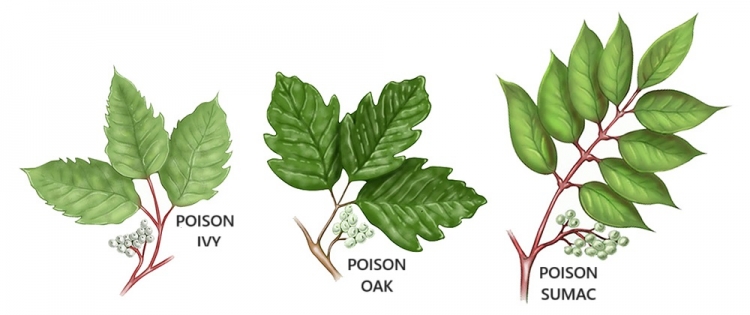Outsmarting poison ivy, poison oak and poison sumac
U.S.Food and Drug Administration (FDA)
Poison ivy, poison oak, and poison sumac are a year-round hazard. First comes the itching, then a red rash, and then blisters. These symptoms of poison ivy, poison oak, and poison sumac can emerge any time from a few hours to several days after exposure to the plant oil found in the sap of these poisonous plants. The culprit: the urushiol oil.
Recognizing Poison Ivy, Poison Oak, and Poison Sumac
Poison Ivy:
Found throughout the United States except Alaska, Hawaii, and parts of the West Coast. It grows as a vine or small shrub trailing along the ground or climbing on low plants, trees and poles. Each leaf has three glossy leaflets, with smooth or toothed edges. Leaves are reddish in the spring, green in the summer, and yellow, orange, or red in the fall. May have greenish-white flowers and whitish-yellow berries.
Poison Oak:
Grows as a low shrub in the Eastern and Southern United States, and in tall clumps or long vines on the Pacific Coast. Fuzzy green leaves in clusters of three are lobed or deeply toothed with rounded tips. May have yellow-white berries.
Poison Sumac:
Grows as a tall shrub or small tree in bogs or swamps in the Northeast, Midwest, and parts of the Southeast. Each leaf has clusters of 7 to 13 smooth-edged leaflets. Leaves are orange in the spring, green in the summer, and yellow, orange, or red in the fall. May have yellow-greenish flowers and whitish-green fruits that hang in loose clusters.
Rashes Caused By Poison Plants Are Not Contagious
Poison ivy and other poison plant rashes do not spread from person to person. But it is possible to pick up the rash from plant oil that may have stuck to clothing, pets, garden tools, and other items that have come in contact with these plants. The plant oil lingers (sometimes for years) on virtually any surface until it’s washed off with water or rubbing alcohol.
The rash will occur only where the plant oil has touched the skin, so a person with poison ivy can’t spread it on the body by scratching. It may seem like the rash is spreading, if it appears over time instead of all at once. But this is either because the plant oil is absorbed at different rates on different parts of the body or because of repeated exposure to contaminated objects or plant oil trapped under the fingernails. Even if blisters break, the fluid in the blisters is not plant oil and cannot further spread the rash.
Tips for Prevention
• Learn what poison ivy, oak, and sumac plants look like so you can avoid them.
• Wash your garden tools and gloves regularly. If you think you may be working around poison ivy, wear long sleeves, long pants tucked into boots, and impermeable gloves.
• Wash your pet if it may have brushed up against poison ivy, oak, or sumac. Use pet shampoo and water while wearing rubber gloves, such as dishwashing gloves. Most pets are not sensitive to poison ivy, but the oil can stick to their fur and cause a reaction in someone who pets them.
• Wash your skin in soap and cool water as soon as possible if you come in contact with a poisonous plant. The sooner you cleanse the skin, the greater the chance that you can remove the plant oil or help prevent further spread.
Tips for Treatment
Don’t scratch the blisters. Bacteria from under your fingernails can get into them and cause an infection. The rash, blisters, and itch normally disappear in several weeks without any treatment.
You can relieve the itch by:
• Using wet compresses or soaking in cool water.
• Applying over-the-counter (OTC) topical corticosteroid preparations or taking prescription oral corticosteroids.
• Applying topical OTC skin protectants, such as zinc acetate, zinc carbonate, zinc oxide, and calamine dry the oozing and weeping of poison ivy, poison oak, and poison sumac. Protectants such as baking soda or colloidal oatmeal relieve minor irritation and itching. Aluminum acetate is an astringent that relieves rash.
See a doctor if:
• You have a temperature over 100 degrees Fahrenheit.
• There is pus, soft yellow scabs, or tenderness on the rash.
• The itching gets worse or keeps you awake at night.
• The rash spreads to your eyes, mouth, genital area, or covers more than one-fourth of your skin area.
• The rash does not improve within a few weeks.
• The rash is widespread and severe.
• You have difficulty breathing.
